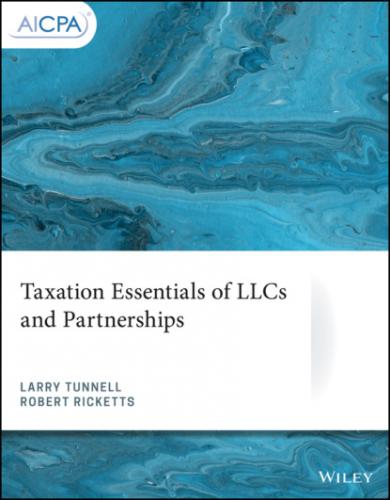207 A 22
208 A 23
209 A 24
210 A 25
211 A 26
212 A 27
213 A 28
214 A 29
215 A 30
216 A 31
217 A 32
218 Tax Glossary 1
219 Tax Glossary 2
220 Tax Glossary 3
221 Tax Glossary 4
222 Tax Glossary 5
223 Tax Glossary 6
224 Tax Glossary 7
225 Index 1
226 Solutions 1
227 Solutions 2
228 Solutions 3
229 Solutions 4
230 Solutions 5
231 Solutions 6
232 Solutions 7
233 Solutions 8
234 Solutions 9
235 Solutions 10
236 Solutions 11
237 Solutions 12
238 Solutions 13
TAXATION ESSENTIALS OF LLCS AND PARTNERSHIPS
BY LARRY TUNNELL, PH.D., CPA,ROBERT RICKETTS, PH.D., CPA
Notice to readers
Taxation Essentials of LLCs and Partnerships is intended solely for use in continuing professional education and not as a reference. It does not represent an official position of the American Institute of Certified Public Accountants, and it is distributed with the understanding that the author and publisher are not rendering legal, accounting, or other professional services in the publication. This course is intended to be an overview of the topics discussed within, and the author has made every attempt to verify the completeness and accuracy of the information herein. However, neither the author nor publisher can guarantee the applicability of the information found herein. If legal advice or other expert assistance is required, the services of a competent professional should be sought.
You can qualify to earn free CPE through our pilot testing program.
If interested, please visit https://aicpacompliance.polldaddy.com/s/pilot-testing-survey.
© 2019 Association of International Certified Professional Accountants, Inc. All rights reserved.
For information about the procedure for requesting permission to make copies of any part of this work, please email [email protected] with your request. Otherwise, requests should be written and mailed to Permissions Department, 220 Leigh Farm Road, Durham, NC 27707-8110 USA.
ISBN 978-1-11972-232-8 (Paper)
ISBN 978-1-11972-228-1 (ePDF)
ISBN 978-1-11972-229-8 (ePub)
ISBN 978-1-11972-230-4 (oBook)
Course Code: 746522 TLLLO GS-0419-0A Revised: March 2019
Chapter 1 Overview: Basic Tax Structure of Partnerships and LLCs
Learning objectives
Distinguish between the various types of partnerships and limited liability companies (LLCs).
Identify the effects of investor contributions and distributions on their basis in a partnership or LLC interest.
Determine how partnerships and LLCs opting to be treated as partnerships report their federal taxable income to the IRS and to investors.
Identify considerations related to the application of the check-the-box rules when electing to treat an entity as a partnership, LLC, or corporation.
Compute the tax consequences of converting from a corportion to an LLC (or partnership);
Recognize when pass-through income from a partnership or LLC is subject to the self-employment tax.
What is a partnership for federal income tax purposes?
For tax purposes, a partnership exists when two or more taxpayers join together, without incorporating, to carry on business or investment activities for their mutual (or “joint”) benefit. Partnerships can be used to conduct active businesses or to carry on investment activities. Moreover, the partnership can be structured in such a way that some partners participate actively in partnership operations while others play the role of passive investors, content to share in the profits (or losses) derived from partnership operations while playing no active role in day-to-day management activities. The primary strength of the partnership as a vehicle for conducting business is its flexibility. Partners can, for example, agree to share differently in the risks and rewards associated with partnership business activity. Yet, the partnership can still provide limited exposure to business risks for certain of its partners (for example, limited partners), providing the best of both worlds: (a) highly flexible arrangements for sharing in the risks and rewards of business activities and (b) limited liability for members. Moreover, unlike corporations, partnership income is subject only to one layer of tax-imposed at the partner level. For these reasons, partnerships are the preferred form of organization for a wide variety of business activities.
Partnerships versus other entities
Legal protection
There are several types of partnerships, each with different levels of liability protection for their partners. The first, and most basic, type of partnership is the general partnership. In a general partnership, all partners participate in management of the partnership, and all partners have the legal authority to enter into binding legal relationships on behalf of the partnership. Therefore, for example, if a law firm were organized as a general partnership, each of its partners would have the authority to enter into attorney- client relationships on behalf of the firm. Each of the firm's clients, even if they deal with only one attorney, is represented by the partnership, rather than by an individual attorney. The downside to this arrangement is that claims against the firm, even if due to the actions of only one partner, can be enforced against any and all partners of that firm, to the extent that the partnership's assets are insufficient to satisfy the claim.
